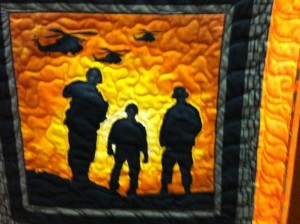Aug
11
AGENT ORANGE: “QUILT OF TEARS”
Filed Under Agent Orange, Combat PTSD, Healing, Tears of a Warrior, Trauma, Veterans | Comments Off on AGENT ORANGE: “QUILT OF TEARS”
by Janet J. Seahorn, Ph.D
It was during our work in Hot Springs, SD with the American Legion and the “Honoring Our Heroes” event that we were able to view for the first time the “Quilt of Tears”. This is an unbelievable sea of orange fabrics with hundreds of patches depicting the stories of those Vietnam veterans and families who have suffered with the effects of Agent Orange.
Much of what is in this blog will be taken from a pamphlet I picked up at the quilt display. The quilt is being cared for, assembled, and driven across the United States by Shelia and Henry Snyder (amrdangel@aol.com).
Many veterans and their family members still do not know much about the effects of exposure to Agent Orange. An accurate number of casualties is “almost impossible to record due to various reasons, but the estimated number has been at 250,000 for quite a few years”, and the number grows every day. Even today, few Americans know that Agent Orange was a powerful herbicide used during the Vietnam War to deforest the jungle in order to set up base camps for our troops. Understanding the effects of Agent Orange on an individual is frightening. These powerful chemicals could literally take down a thick canopy of trees in a short few days. Think about, if it could destroy these huge trees in a matter of days — imagine what these chemicals could do to the fragile human body.
Exposure to Agent Orange can be fatal. Some of the diseases which are currently thought to be a result of these herbicides are Chloracne, Hodgkin’s Disease, Multiple Myeloma, Non-Hodgkin’s Lymphoma, Peripheral Neuropath, Porphyria cutanea tarda, Prostate Cancer, Respiratory Cancers, Soft-Tissue Sarcoma, Type II Diabetes, and illnesses and birth defects for the veteran’s children.
It is essential that veterans who have been exposed to Agent Orange get regular physicals complete with CAT Scans to detect the chemicals related to cancers. As with all diseases, early detection is critical to positive long-term outcomes.
The “Quilt of Tears” is a non-profit organization and relies solely on private donations. To learn more go to the website: www.agentorangequiltoftears.com. Individuals can get information on how they can create his or her own personal patch for the quilt at this site.
“Fear not my great soldier…for your story shall be passed down through the years because the fabric of your life is sewn into the Quilt of Tears.”
Jan
11
ANOTHER HAZARD OF WAR
Filed Under Agent Orange, Tears of a Warrior, War | Comments Off on ANOTHER HAZARD OF WAR
by Tony & Janet Seahorn

There are many Vietnam veterans who have and are continuing to suffer from exposure to AGENT ORANGE. For many, getting adequate information has been a challenge. Because of that challenge, we decided to put the following information on Agent Orange in this blog. We hope it will be of some help.
Presumption of Exposure — A veteran who, during active military, naval, or air service, served in the Republic of Vietnam during the period beginning on January 9, 1962 and ending on May 7, 1975, will be presumed to have been exposed to an herbicide agent during such service, unless there is affirmative evidence that establishes that the veteran was not exposed to any such herbicide agent.
Length of Exposure — There is no regulatory requirement as to how long the veteran was in Vietnam; even a few hours of service in country is sufficient to establish the presumption of exposure. The last date on which a veteran will be presumed to have been exposed to an herbicide agent will be the last date on which he or she served in the Republic of Vietnam during the period beginning on January 9, 1962 and ending on May 7, 1975.
Presumptive Service Connection (herbicide-related diseases)
If a veteran has one of the diseases listed in 38 C.F.R. § 3.309(e) (see Appendix A) and his/her exposure to an herbicide is either presumed, based on service in Vietnam, or otherwise proven by the evidence, the disease is presumed to be related to the in-service exposure.
The all inclusive list, according to the VA site now reads:
- Acute and Subacute Peripheral Neuropathy
A nervous system condition that causes numbness, tingling, and motor weakness. Under VA’s rating regulations, it must be at least 10% disabling within 1 year of exposure to Agent Orange and resolve within 2 years after the date it began. - AL Amyloidosis
A rare disease caused when an abnormal protein, amyloid, enters tissues or organs. - B Cell Leukemias
Cancers which affect B cells, such as hairy cell leukemia. - Chloracne (or Similar Acneform Disease)
A skin condition that occurs soon after dioxin exposure and looks like common forms of acne seen in teenagers. Under VA’s rating regulations, chloracne (or other acneform disease similar to chloracne) must be at least 10% disabling within 1 year of exposure to Agent Orange. - Chronic Lymphocytic Leukemia
A disease that progresses slowly with increasing production of excessive numbers of white blood cells. - Diabetes Mellitus (Type 2)
A disease characterized by high blood sugar levels resulting from the body’s inability to respond properly to the hormone insulin. - Hodgkin’s Disease
A malignant lymphoma (cancer) characterized by progressive enlargement of the lymph nodes, liver, and spleen, and by progressive anemia. - Ischemic Heart Disease
A disease characterized by a reduced supply of blood to the heart. - Multiple Myeloma
A cancer of specific bone marrow cells that is characterized by bone marrow tumors in various bones of the body. - Non-Hodgkin’s Lymphoma
A group of cancers that affect the lymph glands and other lymphatic tissue. - Parkinson’s Disease
A motor system condition with symptoms that include trembling of the limbs and face and impaired balance. - Porphyria Cutanea Tarda
A disorder characterized by liver dysfunction and by thinning and blistering of the skin in sun-exposed areas. Under VA’s rating regulations, it must be at least 10% disabling within 1 year of exposure to Agent Orange. - Prostate Cancer
Cancer of the prostate; one of the most common cancers among men. - Respiratory Cancers
Cancers of the lung, larynx, trachea, and bronchus. - Soft Tissue Sarcoma (other than Osteosarcoma, Chondrosarcoma, Kaposi’s sarcoma, or Mesothelioma)
A group of different types of cancers in body tissues such as muscle, fat, blood and lymph vessels, and connective tissues.
Here is the link, as well:
http://www.publiche alth.va.gov/ exposures/ agentorange/ diseases. asp#veterans



